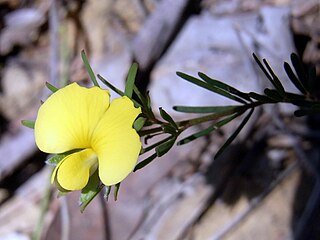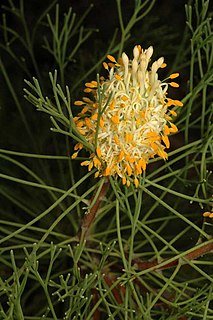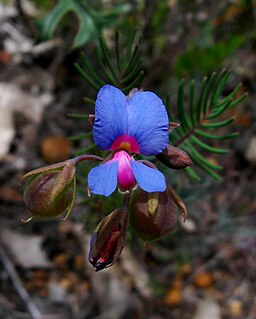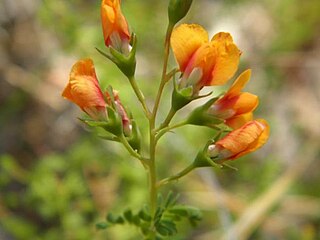
Isopogon dubius, commonly known as pincushion coneflower, is a species of plant in the family Proteaceae and is endemic to the south-west of Western Australia. It is a shrub with sharply-pointed, deeply lobed or pinnate leaves and more or less spherical heads of pink to reddish pink flowers.

Gompholobium ecostatum, commonly known as dwarf wedge-pea, is a species of flowering plant in the family Fabaceae and is endemic to southern Australia. It is a low-lying to erect shrub with trifoliate leaves with linear to lance-shaped leaflets, and apricot-coloured to reddish, sometimes yellow flowers.

Petrophile macrostachya is a species of flowering plant in the family Proteaceae and is endemic to southwestern Western Australia. It is an erect shrub with prickly, pinnate or lobed leaves, and oblong or cylindrical heads of glabrous yellow to cream-coloured flowers.

Gompholobium huegelii, commonly known as common wedge-pea is a species of flowering plant in the family Fabaceae and is endemic to south-eastern Australia. It is an erect or spreading shrub with trifoliate leaves and cream-coloured to yellow and greenish, pea-like flowers.

Gompholobium grandiflorum, commonly known as large wedge-pea, is a species of flowering plant in the family Fabaceae and is endemic to eastern New South Wales. It is an erect, more or less glabrous shrub with trifoliate leaves and lemon-yellow and greenish, pea-like flowers.

Gompholobium glabratum, commonly known as dainty wedge-pea, is a species of flowering plant in the family Fabaceae and is endemic to south-eastern continental Australia. It is a low-lying or ascending shrub with pinnate leaves that have five to seven leaflets, and yellow and green or greyish flowers.

Isopogon divergens, commonly known as spreading coneflower, is a species of plant in the family Proteaceae and is endemic to the south-west of Western Australia. It is a shrub with pinnate leaves and more or less spherical heads of glabrous pink flowers followed by an oval to cylindrical fruiting cone.

Hovea chorizemifolia, commonly known as the holly-leaved hovea, is a species of flowering plant in the family Fabaceae and is endemic to the south-west of Western Australia. It is a small, upright shrub with prickly, green leaves and blue-purple pea flowers.

Petrophile fastigiata is a species of flowering plant in the family Proteaceae and is endemic to southwestern Western Australia. It is a shrub with pinnately-divided leaves with needle-shaped pinnae and sticky, oval heads of glabrous yellow to cream-coloured flowers.

Boronia dichotoma is a plant in the citrus family, Rutaceae and is endemic to the south-west of Western Australia. It is an erect, slender perennial herb or shrub with simple leaves and pink, four-petalled flowers. The species is characterised by sticky glandular hairs on the pedicels.

Boronia ovata is a plant in the citrus family, Rutaceae and is endemic to the south-west of Western Australia. It is an open shrub with simple, egg-shaped leaves and pink to mauve four-petalled flowers. It is found in the Darling Range near Perth.
Gompholobium aspalathoides is a species of flowering plant in the family Fabaceae and is endemic to eastern Australia. It is an erect, more or less glabrous shrub with trifoliate leaves with linear to narrow elliptic leaflets, and yellow pea-like flowers.

Gompholobium capitatum, commonly known as yellow pea, is a species of flowering plant in the family Fabaceae and is endemic to the south-west of Western Australia. It a slender, erect or ascending shrub with pinnate leaves and yellow flowers.

Gompholobium cyaninum is a species of flowering plant in the family Fabaceae and is endemic to the south-west of Western Australia. It is an erect to straggling shrub with pinnate leaves and blue, purple and red, pea-like flowers.

Gompholobium foliolosum is a species of flowering plant in the family Fabaceae and is endemic to eastern Australia. It is an erect shrub with pinnate leaves and orange-red, pea-like flowers.
Gompholobium gairdnerianum is a species of flowering plant in the family Fabaceae and is endemic to the far west of Western Australia. It is an erect, slender, multistemmed shrub with yellow, pea-like flowers.
Gompholobium glutinosum is a species of flowering plant in the family Fabaceae and is endemic to the far west of Western Australia. It is an erect, openly-branched shrub with pinnate leaves with three to five leaflets, and yellow and red, pea-like flowers.
Gompholobium gompholobioides is a species of flowering plant in the family Fabaceae and is endemic to the south-west of Western Australia. It is a spreading shrub with pinnate leaves and uniformly yellow, pea-like flowers.
Gompholobium hendersonii is a species of flowering plant in the family Fabaceae and is endemic to the south-west of Western Australia. It is an erect shrub with simple leaves, and red and purplish-brown, pea-like flowers.
Gompholobium karijini is a species of flowering plant in the family Fabaceae and is endemic to the north-west of Western Australia. It is an erect, openly-branched shrub with pinnate leaves with five to ten pairs of leaflets, and racemes of yellow to orange and creamy-yellow, pea-like flowers.














